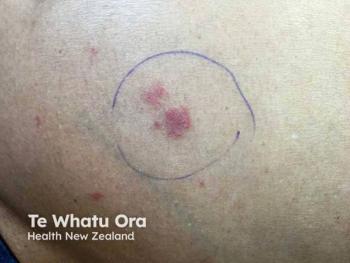
- Dermatology Times, May 2021 (Vol. 42, No. 5)
- Volume 42
- Issue 5
Emerging Biologics Make Waves in AD
A new generation of inhibitors take aim at key sources of inflammation.
Targeted biologic therapies have become increasingly important in the treatment of atopic dermatitis (AD), according to Leon Kircik, MD, clinical professor of dermatology at Icahn School of Medicine at Mount Sinai in New York City, New York, and medical director of DermResearch, PLLC, Physicians Skin Care, PLLC, and Skin Sciences, PLLC, located in Louisville, Kentucky. Given the growing range of new treatments coming to market, their impact is likely to expand.
Kircik profiled emerging biologics in the pipeline to treat AD at the Inaugural Symposium for Inflammatory Skin Disease (SISD) which was held live virtually April 9-11, 2021.1 Some of the major targets for these new products include pro-inflammatory cytokines such as interleukin (IL)-4, IL-5, IL-13, IL-31, IL-33, and thymic stromal lymphopoietin (TSLP).
“This is the golden era for atopic dermatitis in dermatology and we are very lucky that we have so many options to treat our patients,” Kircik said.
Biologics on the Market
As for biologic treatments currently available for AD, Kircik said dupilumab (Dupixent; Sanofi Genzyme and Regeneron Pharmaceuticals) is an “oldie, but a goodie.”
According to the National Eczema Association, dupilumab is the first and currently only FDA-approved biologic treatment for AD.2 This fully human monoclonal antibody inhibits IL-4 and IL-13 signaling.
In May 2020, the FDA approved expanding the label for dupilumab to include patients as young as 6 years, making it the first biologic approved to treat moderate to severe AD in pediatric patients between the ages of 6 and 11 years.3 Kircik said this approval was important because most of his patients with AD are pediatric.
In the presentation, Kircik also pointed out results from 2 randomized, placebo-controlled, parallel, phase 3 trials that evaluated dupilumab vs placebo in adult patients with moderate to severe AD that was inadequately controlled by topical treatment.4
The primary end point in the trials, SOLO 1 (NCT02277743) and SOLO 2 (NCT02277769), was the proportion of patients who had an Investigator Global Assessment (IGA) score of 0 or 1 (clear or almost clear) and a 2-point or more reduction from baseline at week 16.
Data from SOLO 1 revealed 38% of patients who received dupilumab every other week and 37% who received dupilumab weekly achieved the primary end point vs 10% who received placebo. In SOLO 2, 36% who received dupilumab every other week and 36% who received dupilumab weekly achieved the primary end point, compared with 8% who received placebo, respectively.
Conjunctivitis emerged as a prominent adverse event (AE) in patients on dupilumab, Kircik said. The cause of this still unknown, he added
“When you look at studies with dupilumab with other indications such as asthma, we don’t see the same incidence of conjunctivitis,” Kircik said. “It’s very low for those indications, unlike atopic dermatitis, where we see quite a bit compared to the patients receiving placebo. So, the bottom line is that further study is needed to elucidate the etiology of the conjunctivitis.”
What's New?
Kircik said variety of new biologics that will soon hit the market. One is tralokinumab (LEO Pharma), a fully human monoclonal antibody that targets IL-13. In 2 clinical trials evaluating the safety and efficacy of tralokinumab as a monotherapy in adult patients with moderate to severe AD (ECZTRA 1 [NCT03131648] and ECZTRA 2 [NCT03160885]), investigators observed a significantly greater IGA 0/1 response with the biologic at week 16 compared with placebo.5
Additionally, all primary and secondary end points were met in both trials, including an IGA response of clear or almost clear at week 16 and a minimum change from baseline of 75% or greater at week 16. The secondary end points include a change from baseline in week 16 in SCORing of AD (SCORAD), Pruritus Numerical Rating Scale (NRS) of 4 and Dermatology Life Quality Index (DLQI).
Another biologic in the pipeline is lebrikizumab (Eli Lilly). A recent phase 2b clinical trial (NCT03443024) showed this high-affinity IL-13 inhibitor significantly improved manifestations and symptoms of AD with a safety profile similar to placebo.6
“Lebrikizumab showed rapid, dose-dependent efficacy across a broad range of key [AD] clinical manifestations, including skin lesions, pruritus, and quality of life, in adult patients with moderate-to-severe [AD] not previously controlled by standard topical therapies,” the study authors wrote.
Nemolizumab, a humanized monoclonal antibody that blocks signaling to the IL-31 receptor A, is currently being investigated as a treatment for pruritus, a common symptom of AD.
In 2020, nemolizumab was studied in a 16-week trial (NCT04365387) for the treatment of pruritus associated with AD.7 The study authors wrote, “In this 16-week trial, the use of subcutaneous nemolizumab in addition to topical agents for atopic dermatitis resulted in a greater reduction in pruritus than placebo plus topical agents.”
“The incidence of injection-site reactions was greater with nemolizumab than with placebo. Longer and larger trials are necessary to determine whether nemolizumab has a durable effect and is safe for atopic dermatitis,” they added.
Other biologics on the horizon include tezepelumab (AMG-157; AstraZeneca and Amgen), a potential first-in-class human monoclonal antibody that inhibits the action of TSLP, which may prevent the release of pro-inflammatory cytokines by immune cells, and etokimab (ANB-020; AnaptysBio), an anti–IL-33 antibody.
New Mechanisms of Actions
Investigators are also studying a novel mechanism of action (MOA), sphingosine 1-phosphate (S1P) receptor modulation. This process has been found to selectively reduce migration of lymphocytes from the lymph nodes.
“What happens is we have lymphocytes that come out of the lymph nodes, and they travel to tissue where they cause inflammation,” Kircik said. “If you find a way that stops that travel of the lymphocytes to the tissue from the lymph nodes, then you will be able to decrease the inflammation and tissue damage. One of the ways to do that is S1P receptor modulation.”
Currently, etrasimod (Arena Pharmaceuticals), a small molecule which employs this new MOA, is being investigated in a phase 3 clinical trial.8
Kircik sees this robust research pace continuing, bringing more options for optimizing AD outcomes in all patient populations.
Disclosures:
Kircik reports he has received funding as an investigator, consultant or speaker from Abbott, Acambis, Aclaris, Allergan, Almirall, Amgen, Anacor, AnaptysBio, Astellas, Asubio, Bristol Myers Squibb, Berlex, Biogen, BioLife, Biopelle, Boehringer Ingelheim, Breckenridge Pharma, Brickell, Cellceutix, Celgene, Centocor, Cipher, Coherus, ColBar LifeScience, CollaGenex, CombiMatrix, Connetics, Coria, Dermavant, Dermik, Dermira, Dow, DUSA Pharmaceuticals, Eli Lilly and Company, Exeltis, EOS, Ferndale, Galderma, Genentech, GlaxoSmithKline, HealthPoint Biotherapeutics, Idera, Intendis, ISDIN, Johnson & Johnson, 3M, LEO, L’Oréal, MC2, Maruho, Medicis, Merck, Merz, NanoBio, Novartis, Novan, NUCRYST, Obagi, Onset Therapeutics, OrthoNeutrogena, Pediapharma, Pfizer, PharmaDerm, Promius, PuraCap, QLT, QuatRx, Quinnova, Serono, SkinMedica, Stiefel, Sun Pharma, Taro, Tolerx, Triax Pharmaceuticals, UCB, Valeant, Warner Chilcott, XenoPort, and ZAGE.
References:
1. Kircik L. Biologics in the pipeline for atopic dermatitis. Presented at: Inaugural Symposium for Inflammatory Skin Disease; April 9-11, 2021; virtual.
2. Jones K. Two new atopic dermatitis biologics show promising results in phase IIb clinical trials. National Eczema Association. July 15, 2019. Accessed April 14, 2021. https://nationaleczema.org/nemolizumab-lebrikizumab/
3. FDA approves Dupixent (dupilumab) as first biologic medicine for children aged 6 to 11 years with moderate-to-severe atopic dermatitis. News release. Sanofi. May 26, 2020. Accessed April 14, 2021. http://www.news.sanofi.us/2020-05-26-FDA-approves-Dupixent-R-dupilumab-as-first-biologic-medicine-for-children-aged-6-to-11-years-with-moderate-to-severe-atopic-dermatitis
4. Simpson EL, Bieber T, Guttman-Yassky E, et al. Two phase 3 trials of dupilumab versus placebo in atopic dermatitis. N Engl J Med. 2016;375(24):2335-2348. doi:10.1056/NEJMoa1610020
5. Simpson E, Blauvelt A, Guttman-Yassky E, et al. (2020). Efficacy and safety of tralokinumab monotherapy in adult patients with moderate-to-severe atopic dermatitis: results from two 52-week, phase 3 trials (ECZTRA 1 and ECZTRA 2). J Cutan Med Surg. 2020;4(6)(suppl 92). doi:
6. Guttman-Yassky E, Blauvelt A, Eichenfield LF, et al. Efficacy and safety of lebrikizumab, a high-affinity interleukin 13 inhibitor, in adults with moderate to severe atopic dermatitis: a phase 2b randomized clinical trial. JAMA Dermatol. 2020;156(4):411-420. doi:10.1001/jamadermatol.2020.0079
7. Kabashima K, Matsumura T, Komazaki H, Kawashima M. Trial of nemolizumab and topical agents for atopic dermatitis with pruritus. N Engl J Med. 2020;383(2):141-150. doi:10.1056/NEJMoa1917006
8. Arena Pharmaceuticals. advancing etrasimod into phase 3 program in atopic dermatitis (Ad), reports compelling topline results from phase 2b ADVISE trial. News release. Arena Pharmaceuticals. November 9, 2020. Accessed April 14, 2021. https://www.prnewswire.com/news-releases/arena-pharmaceuticals-advancing-etrasimod-into-phase-3-program-in-atopic-dermatitis-ad-reports-compelling-topline-results-from-phase-2b-advise-trial-301169037.html
Articles in this issue
over 4 years ago
Administrative Burden of Prescribing Biologicsover 4 years ago
Master Techniques to Treat Eye Issuesover 4 years ago
Current and Upcoming Topicals in the Pipeline for ADover 4 years ago
Off-label Biologics Target Wide Range of Skin Diseasesover 4 years ago
Debunking Sunscreen Controversiesover 4 years ago
Off-label Sarecycline Combats Papulopustular Rosaceaover 4 years ago
What’s Trending in Skin Care? May 2021over 4 years ago
Game Changers in DermatologyNewsletter
Like what you’re reading? Subscribe to Dermatology Times for weekly updates on therapies, innovations, and real-world practice tips.


















